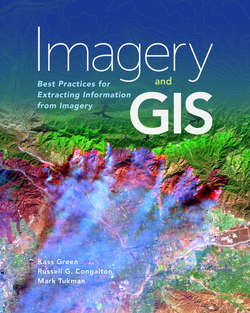Читать книгу Imagery and GIS - Kass Green - Страница 61
На сайте Литреса книга снята с продажи.
Selection Framework—What’s Required versus What’s Available
ОглавлениеThe usefulness of a particular imagery product will depend on its technical and organizational characteristics as well as how those characteristics meet the needs of users. Sometimes an analyst has no choice regarding the type of imagery to be used and has to make do with what has been provided by their organization. However, in today’s ever-expanding imagery marketplace, multiple datasets are often available and accessible. Because so much imagery is available, it is also now common for a mapping project to use multiple datasets. For example in the Sonoma Vegetation Mapping project, multiple imagery datasets were used including two years of National Agriculture Imagery Program (NAIP) imagery (4 bands, 1-m spatial resolution), multiple years of Landsat 8 imagery (11 bands, 30-m spatial resolution), Airborne Visible/Infrared Imaging Spectrometer (AVIRIS) hyperspectral imagery, 4-band multispectral, 1-foot imagery collected in 2011 by the county, and quality level 1 lidar and 4-band optical imagery (6-inch spatial resolution) flown specifically for the project.
No matter how large or small, each image acquisition will require trade-offs between imagery characteristics. It’s not uncommon for imagery analysts to want to use the best spatial, temporal, and spectral resolutions available. However, not every project requires or can afford the highest resolutions possible. Higher resolutions usually translate into higher costs and limited accessibility or both, due to licensing, increased storage, and processing times. Rather, imagery should be chosen to fulfill the project requirements. Products should be substituted for one another and trade-offs made, especially between price, spatial resolution, spectral resolution, temporal resolution, and licensing restrictions.
To determine what is required by a project instead of what is desired or available, the analyst can ask several simple questions that will narrow the choice of imagery. They are:
1 1.Will the imagery be used for visualization or to make a map?
2 2.What is the smallest item to be identified on the ground?
3 3.What is the time frame of the project and its results?
4 4.What types of features need to be mapped?
5 5.What is the size, shape, and accessibility of the project area?
6 6.What are the requirements for spatial and spectral accuracy?
7 7.Will the imagery be shared with other organizations?
8 8.Is the imagery accessible?
9 9.What is the project budget?
It is the combined answers to all these questions that will determine which type(s) of imagery will best meet the needs of the project. Often some project requirements must be relaxed, and the questions asked and reasked multiple times before the answers converge on a particular set of imagery products.
